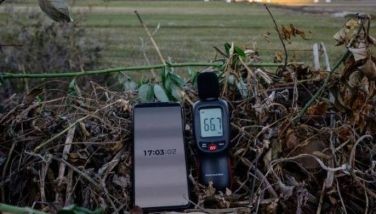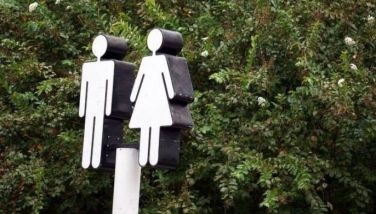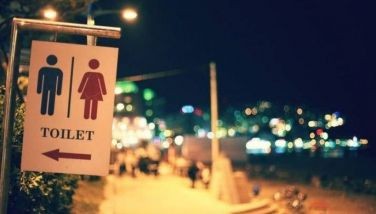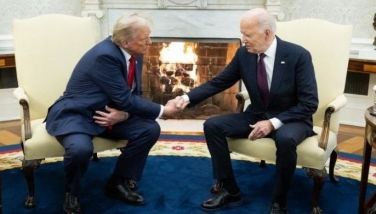Iraqi forces, militias sweep into Islamic State-held Tikrit
BAGHDAD — Iraqi soldiers and allied Shiite militiamen swept into the Islamic State-held city of Tikrit on yesterday, launching a two-front offensive to squeeze extremists out of Saddam Hussein's hometown in a major test of the troops' resolve.
Explosions and heavy gunfire echoed through Tikrit, a key way station for Iraqi forces trying to expel the militants who hold roughly a third of the country and neighboring Syria. The battle also will serve as a major crucible for Iraqi forces, which collapsed under the extremists' initial offensive last year and now face street-by-street fighting in one of the Islamic State group's biggest strongholds.
Allied Iraqi forces first entered the city through its northern Qadisiyya neighborhood, according to video obtained by The Associated Press. Overhead, an attack helicopter fired missiles as soldiers and militiamen laid down heavy machine gunfire in the neighborhood's dusty streets as downtown Tikrit loomed in the distance, black smoke rising overhead.
Officials quickly established a supply line through the neighborhood to reinforce troops, Salahuddin police Brig. Kheyon Rasheed told the state-run Iraqiyya television. Authorities offered no immediate casualty figures, though Iran's state-run, English-language Press TV satellite channel reported that a mortar attack wounded one of its cameramen there.
A local official in Iraq's Salahuddin province confirmed that Iraqi troops entered Qadisiyya, and penetrated the northern suburbs, raising the Iraqi flag over Tikrit's general hospital. He spoke on condition of anonymity as he was not authorized to brief journalists.
Later yesterday, allied forces also swept into Tikrit from the south in a pincer movement to squeeze out militants, though some suggested many already fled in the face of the advance.
"The terrorists are seizing the cars of civilians trying to leave the city and they are trying to make a getaway," Rasheed said.
Tikrit, the capital of Salahuddin province, sits on the Tigris River about 130 kilometers (80 miles) north of Baghdad. Several of Saddam's palaces remain there, as do remnants of his now-outlawed Baathist party. Many believe party members assisted the Islamic State group in its initial offensive last summer that saw the city fall into their hands.
After the 2003 US-led invasion of Iraq, insurgent Baathists launched attacks on American forces. The same could happen to incoming Iraqi forces, who moved slowly into the city after coming under sniper fire and dealing with heavily mined roads.
Taking Tikrit would open a supply line for a future operation to besiege Mosul, Iraq's second-largest city that still remains under Islamic State control. US military officials have that said a coordinated military mission to retake Mosul likely will begin in April or May and involve up to 25,000 Iraqi troops. But the Americans have cautioned that if the Iraqis are not ready, the offensive could be delayed.
Iranian military advisers have been helping guide Iraqi forces in their advance on Tikrit. Among those directing operations is Iranian Gen. Qassem Soleimani, commander of the powerful Revolutionary Guard's Quds Force.
Frontline images have emerged of the general in recent days, showing him smiling and marching alongside tanks and ground troops in plainclothes without a bulletproof vest. The overt Iranian role and the prominence of Shiite militias in the campaign have raised fears of possible sectarian cleansing should Tikrit, an overwhelmingly Sunni city, fall to the government troops.
"Iranians will try to calm the fears of the Sunnis instead of persecuting them because the Iranian officials know that it is in their best interest to keep the Iraq united," said Hadi Jalo, a Baghdad-based political analyst. "For the Iranians, it is easier to dominate one country instead of three separate states."
The US says its allied coalition carrying out airstrikes targeting the extremists has not been involved in the ongoing Tikrit offensive. Iraq's Prime Minister Haider al-Abadi has appealed for more aid for his country's beleaguered ground forces, though the US spent billions of dollars training and equipping Iraq's army during its eight-year occupation.
A senior US military official told the AP that as of June 2014, the Iraqi military stood at 125,000 men at best, down from 205,000 in January 2014. Iraqi officials now say that at least 30,000 men — including the military, militias, Sunni tribes and police — are fighting to capturing Tikrit.
Most battlefield successes in Iraq have been coordinated efforts, with Iraqi and Kurdish forces and Shiite militias fighting on the ground and the US-led coalition providing air power.
The siege on the village of Amirli just north of Baghdad, when many feared the capital itself might fall, was broken last year with the help of US-led airstrikes and a fighting force of mainly Shiite militias. Shiite militiamen backed by a coalition air campaign also retook the town of Jurf al-Sukhr, on Baghdad's outskirts, from the militants in October.
The Islamic State group kept up its attacks elsewhere in Iraq. In Ramadi, the provincial capital of Iraq's embattled Anbar province, at least 13 suicide car bombs exploded almost simultaneously, killing two soldiers and wounding eight, said Sabah Karhout, head of the Anbar provincial council. The Islamic State group said in an online statement that it used foreign fighters from Australia, Belgium, Syria and Uzbekistan fighters in the attack.
A car bomb also exploded near a clinic in a Shiite neighborhood in northern Baghdad, killing seven people and wounding 18, authorities said. No one immediately claimed responsibility for the attack, though the Islamic State group has targeted Shiites before in the capital.
- Latest
- Trending
































